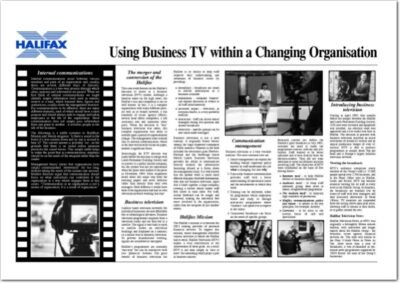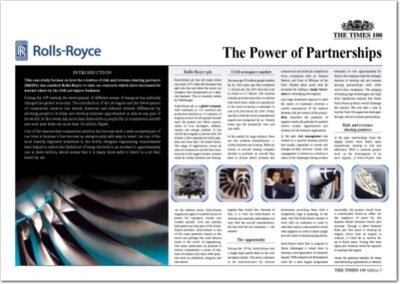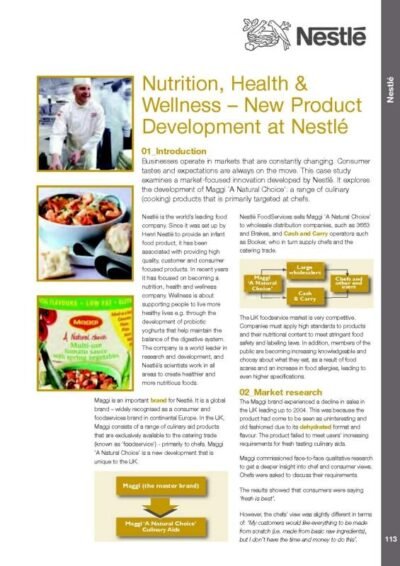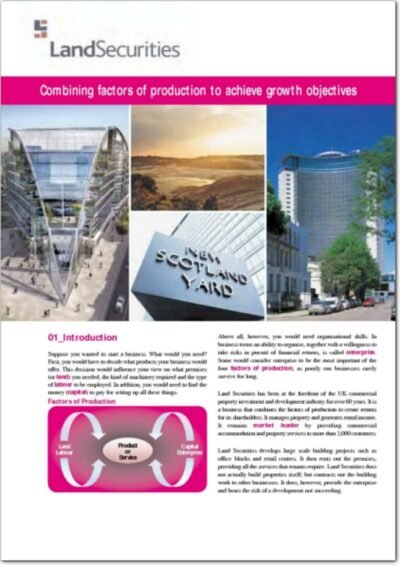Enterprise and risk

Enterprise refers to all the organisational skills that go into creating a product or service. It also includes a willingness and ability to take risks in order to gain rewards and to think up new products or services. Land Securities manages its risks by making sure it has a balanced portfolio. The portfolio will contain some developments that carry a substantial element of risk but which, if successful, will bring high returns. It will also contain lower risk activities, which ensure a steady income stream. Land Securities has a well-established risk management strategy that follows the six steps shown in the diagram.
Risk Management at Land Securities
- Identify the business goals and objectives (the reasons why risks are taken).
- Identify the risks.
- Measure the level of risk.
- Develop action plans to manage the risks.
- Assess the risks again after they have been managed.
- Report at each stage.
This company combines this strategy with innovation – thinking up new products and services to meet clients’ needs. Examples of these include:
- Property outsourcing – Land Securities Trillium is the market leader here.
- Additional client services – e.g. building maintenance, cleaning, reception and security.
- Landflex – this enables clients to change the size of their accommodation over time and to have flexible leases on property.
In addition to thinking up new lines of business, Land Securities must monitor its ongoing activities. It constantly checks its portfolio of properties and projects to ensure that they are producing the best possible returns. This involves carefully managing the other three factors of production.
Land and labour
‘Land’ in economic and business terms includes earth, sea and sky and all the natural resources within them. Like nearly all economic resources, land is scarce – there is less of it available than people want to use, therefore people must pay to own or use it. When firms use land efficiently, the land rises in value. Land Securities often puts land to new uses. If the buildings already on it are no longer serviceable, the company will demolish them and redevelop the site. If, however, the buildings still have potential, Land Securities will save resources by refurbishing them.

Taking care of the environment is a big issue in the case of land use. Land Securities is careful to manage resources sensitively. It recycles rubble from old buildings into new projects, such as Heathrow’s new Terminal 5, which was built using recycled aggregate. It also works with subcontractors to ensure that buildings are as energy efficient as possible. Land Securities also develops brownfield sites e.g. the Kent Thameside Development of mixed housing and commercial property. The company seeks to minimise the effects its suppliers have on the environment. In particular the Group is looking at all of its sources of paper and timber. As part of its Land Securities Trillium ISO14001 Environmental Certification, it checks all of its potential suppliers’ policies on health, safety and the environment to ensure that its environmental footprint is as small as possible.
Labour is the work done by an economy’s workforce. Different people do different jobs requiring different skills and attributes. Labour, therefore, does not just mean physical effort. It refers to all work done, whether by hand or brain. Land Securities employs nearly 2,000 people across the UK. They are responsible for the management of the property portfolio. They also look after the development and delivery of all the business property services.
The company believes that employees’ performance, and their contribution to achieving business objectives, should be rewarded appropriately. With this in mind it uses pay, incentives and benefits to help motivate its staff. The business communicates openly with employees, so that management and employees can easily exchange ideas or solve problems. Communication includes:
- an intranet that regularly updates employees
- regular presentations on business activities and future plans
- management and staff ‘away days’
- email updates
- various magazines, both on paper and online, including a monthly environmental newsletter.
Land Securities also encourages staff to suggest ideas that might bring benefits to the company. It rewards them for original ideas that prove capable of being put into practice.
The Group looks to recruit and develop the best people for its various business roles. It also offers them ongoing comprehensive training programmes. It sets targets for internal promotion and constantly monitors staff to ensure that people maximise their career opportunities. It runs a ‘Values into Action’ award programme, which rewards employees for demonstrating in the workplace the company’s core values. These are:
- integrity
- respect for the individual
- customer service
- excellence
- innovation.
The company also encourages its employees to be involved in community activities in the areas where they are based. This helps to build good working relationships between the company and local communities.
Workplace legislation

Labour is an important factor of production and managing labour effectively involves understanding workplace legislation. Land Securities looks to comply with all laws relating to the workplace. These include ensuring that nobody is harassed or treated differently because of their age, race, colour, disability, creed, religion, or sexual orientation. The legislation that Land Securities must follow includes:
- Health and Safety at Work Act. Both employers and employees have a duty to work in as safe and healthy a way as possible. Some responsibilities rest with the employer e.g. to provide a safe working environment. Others lie with the employee e.g. not to act in any way that will endanger him/herself or any other worker.
- Equal Pay Act. Men and women should receive equal pay for equal work. If a woman is doing the same work as a man, she should receive the same financial reward. This applies even if a woman’s job has a different title, provided she is doing the same work.
- Sex Discrimination Act. This extended the law to include such matters as recruitment, training, and promotion opportunities. Employers may not discriminate on grounds of an employee’s or applicant’s gender. The government set up the Equal Opportunities Commission to enforce the Act.
- Race Relations Act. This made it illegal to discriminate between people on the grounds of race, colour, marital status, nationality or ethnic group. It also set up the Race Relations Board to investigate complaints. The Act applies to all aspects of employment including job advertisements, recruitment processes such as interviews, and training and promotion opportunities.
- Disability Discrimination Act. Employers with 20 or more staff must not discriminate against applicants or employees on grounds of disability, providing that the applicant is capable of doing the job.
Capital

In the context of factors of production, capital refers to the buildings, machinery, equipment (including vehicles) and tools that businesses use to create goods and services. In this context, capital does not mean ‘money’ but means the real assets that businesses purchase or hire, using money. Land Securities operates in the property market, where capital is a key factor of production. The company’s 2,000 employees manage a portfolio of investment assets worth around £8 billion.
Businesses like Land Securities have to borrow large amounts of money because their activities depend so heavily on physical capital. This borrowing brings them responsibilities to the people or institutions who have helped to finance them through bank loans, bond sales and share issues. Land Securities is a public limited company so it has shareholders who expect a return on their investment. Land Securities’ three divisions compete to see which can generate the best financial performance. The company’s three main divisions are:
- Central London – Its £8.7 billion investment portfolio includes more than 810,000 m2 of office space in London and substantial retail holdings in Oxford Street and Tottenham Court Road. The main driver is to recycle capital in a cyclical market, for example the selective acquisition of properties with active management opportunities rather than simple asset accumulation.
- Retail – The Group owns 18 shopping centres and 25 retail parks located across the UK and its vision is to acquire or develop long-term assets. Land Securities has been selling high street retail, to enable it to drive higher returns through the active management of larger assets.
- Property Outsourcing – This division manages properties on behalf of the clients who own them. It offers a complete buildings management and support service. This leaves the businesses who occupy the buildings to concentrate on what they are good at. They no longer have to deal with day-to-day problems such as caretaking, cleaning and buildings maintenance. Clients for this service include government departments, the BBC and BT.
In addition to this Land Securities have an Urban Community Development division, which is overseeing and master planning one of Europe’s largest regeneration schemes in Kent Thameside. In such a capital-intensive business, the company has to ensure that it is managing risk and also working to achieve the best returns for all of its stakeholder groups.
Conclusion

Land Securities’ stated aim is to create sustainable shareholder returns through good financial management. This relies on careful management of all four factors of production. Land, Labour and Capital are all important, but Enterprise is arguably the most important of all. With its sound organisational and entrepreneurial skills, Land Securities continues to be the market leader in the UK property market.
 Using business TV within a changing organisation (PDF)
Using business TV within a changing organisation (PDF)  The power of partnerships (PDF)
The power of partnerships (PDF)  Coffee - The Supply Chain (PDF)
Coffee - The Supply Chain (PDF)  Nutrition, Health & Wellness - New Product Development at Nestle (PDF)
Nutrition, Health & Wellness - New Product Development at Nestle (PDF)  Combining factors of production to achieve growth objectives (PDF)
Combining factors of production to achieve growth objectives (PDF) 